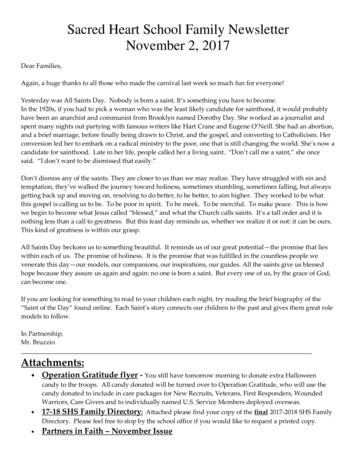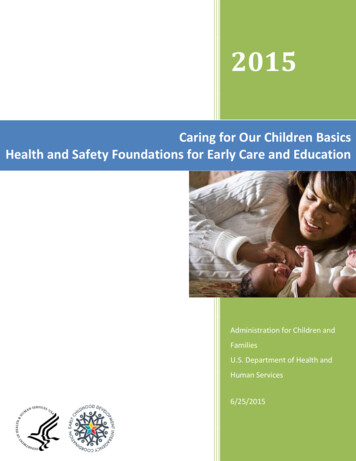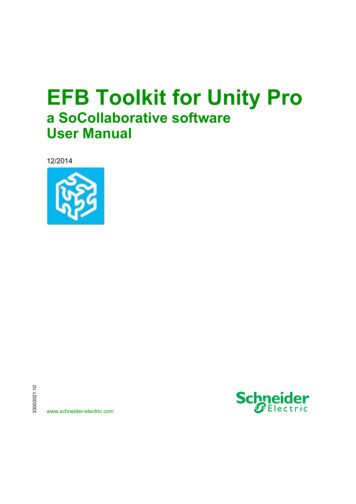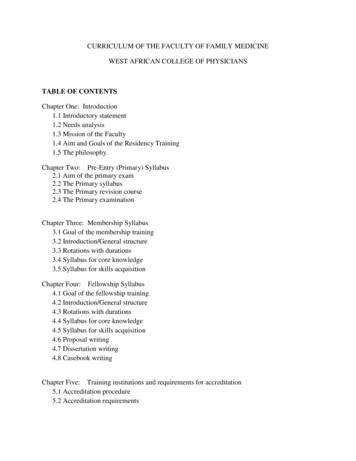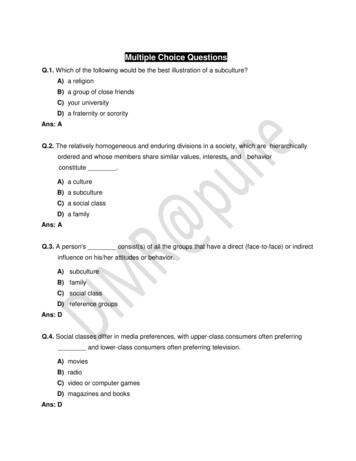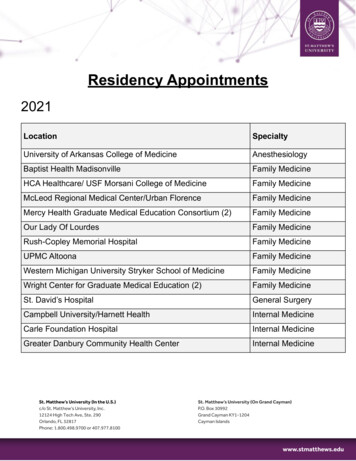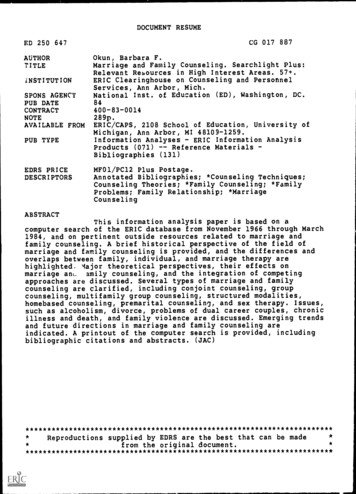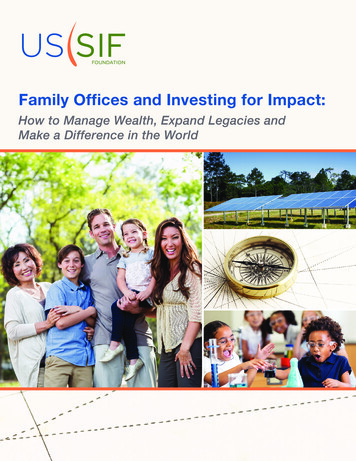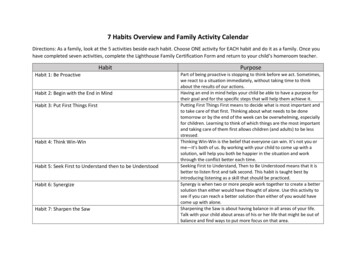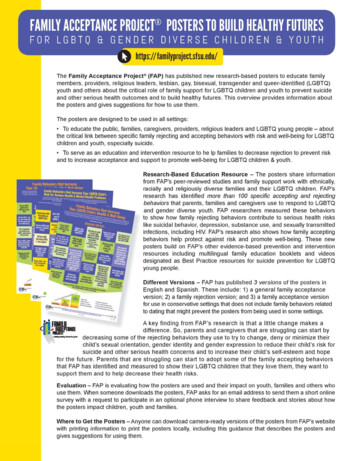
Transcription
Family Behaviors that IncreaseYour LGBTQ Child’s Health & Well-Being Research from the Family Acceptance Project found more than 50 family accepting behaviors that help protect your lesbian, gay, bisexual, transgender andqueer-identified (LGBTQ) child against health risks like depression, suicide and illegal drug use and help to increase your LGBTQ child’s self-esteem, healthand well-being. A little change makes a difference in decreasing your child’s isolation and risk and giving them hope that their family will be there for them.Family support saves lives!BEHAVIORS THAT HELP Tell your LGBTQ /gender diversechild that you lovethemSupport yourchild’s genderexpressionAsk your child if – andhow - you can help themtell other people abouttheir LGBTQ identityWelcome yourchild’s LGBTQfriends to yourhomeParticipate in familysupport groups andactivities for familieswith LGBTQ andgender diverse children to get supportTell your LGBTQ / gender for yourself and yourdiverse child that youfamily and guidancewill be there for them –for supporting youreven if you don’t fullyunderstandLGBTQ childFind a congregationthat welcomes yourLGBTQ / gender diversechild and familyWelcome your child’sLGBTQ partner tofamily events andactivitiesConnect yourchild with LGBTQadult role modelsTalk with your childor foster childabout their LGBTQidentity and listenrespectfully –Require other familymembers to treatyour child withrespecteven when you feeluncomfortable or think thatbeing gay ortransgender is wrongBring your childto LGBTQgroups andeventsUse your child’s chosenname and the pronounthat matches theirgender identityTell your LGBTQ /gender diverse childthat you’re proud ofthemTalk with your religiousleaders to help yourcongregation becomesupportive of LGBTQpeopleStand up for yourchild when othersmistreat thembecause of theirLGBTQ identity orgender expression –at home, at school,in your congregationand in thecommunityExpress enthusiasm for yourchild having an LGBTQ /gender diverse partnerwhen they’re ready to dateShow affection whenyour child tells you orwhen you learn thatyour child is LGBTQGet accurateinformation toeducate yourself about yourchild’s sexualorientation,gender identityand expressionSpeak openly aboutyour child’s LGBTQidentityBelieve that your childcan be a happy LGBTQadult – and tell themthey will have a good lifeThe more of these behaviors that parents and families do, the betteryour LGBTQ child’s health & cceAMORE orilymaFModerateNo or LOWLevels of FamilyAccepting BehaviorsHIGHLevels of FamilyAccepting Behaviors Better health Less likely to be depressed Higher self-esteem 3 times less likely to attempt suicide Stronger social support 3 times less likely to think about suicide Better family relationships Less likely to have substance abuse problemsFamily Accepting Behaviors For more information about acceptance and rejection and your LGBTQ child’s risk & well-being - Family Acceptance Project : https://familyproject.sfsu.eduBiden Foundation’s Family and Community Acceptance Campaign: are 2018, Caitlin Ryan, PhD
Family Behaviors that Increase Your LGBTQ Child’sRisk for Serious Health & Mental Health ProblemsResearch from the Family Acceptance Project shows that more than 50 family rejecting behaviors contribute to serious health risks for lesbian, gay,bisexual, transgender and queer (LGBTQ) youth. These include depression, suicidal behavior, illegal drug use, HIV and sexually transmitted infections (STIs).Family rejection increases risk for homelessness and placement in foster care and juvenile justice facilities.Most parents and families that engage in these behaviors do so out of care and concern – to help their LGBTQ / gender diverse child fit in, have a good life and toprotect them from harm. Help families understand that these and other rejecting behaviors are harmful!BEHAVIORS THAT HURT Prevent your childfrom having anLGBTQ friendDon’t talk aboutyour child’sLGBTQ identityTell your LGBTQ childthat you’re ashamedof themPressure your childto be more(or less) masculineor feminineTell your childthat being LGBTQis “just a phase”Use religion to rejectyour child’s sexualorientation, genderidentity andexpressionTell your child to “tonedown” how they look,dress or behaveTake your childto a therapistor religiousleader to try tochange theirLGBTQ identityMake your child pray orattend religious servicesto change or preventtheir LGBTQ identityBlame your childwhen othersmistreat thembecause of theirLGBTQ identity /genderexpressionTry to change yourchild’s LGBTQ identityor gender expressionDon’t use the name orpronoun that matchesyour child’s genderidentityDon’t let your childtalk about theirLGBTQ identityHit, slap or physicallyhurt your child becausethey are LGBTQ /gender diverseTell your childthat God willpunish thembecause of theirsexualorientation orgender identityCall your child negativenames because they areLGBTQ / gender diverseDon’t let your childparticipate in LGBTQsupport groups orservicesExclude your LGBTQchild from familyevents & activitiesLet othersspeak badlyabout LGBTQ /gender diversepeople in frontof your childDon’t let your childwear clothes or hairstyles that expresstheir gender identityMake your childleave home becausethey are LGBTQThe more of these behaviors that parents and families do,the higher your LGBTQ child’s risk3x2x2x1.5 xDepressionSuicidal thoughtsSuicide attemptsIllegal drug useMORE or ModerateNo or LOWFamily Rejecting BehaviorsLevels of FamilyRejecting Behaviors6x5.5 x8x3x3xDepressionSuicidal thoughtsSuicide attemptsIllegal drug useHIV/STD riskHIGHLevels of FamilyRejecting Behaviors For more information about acceptance and rejection and your LGBTQ child’s risk & well-being - Family Acceptance Project : https://familyproject.sfsu.eduBiden Foundation’s Family and Community Acceptance Campaign: are 2018, Caitlin Ryan, PhD
Family Behaviors that IncreaseYour LGBTQ Child’s Health & Well-Being Research from the Family Acceptance Project found more than 50 family accepting behaviors that help protect your lesbian, gay, bisexual, transgender andqueer-identified (LGBTQ) child against health risks like depression, suicide and illegal drug use and help to increase your LGBTQ child’s self-esteem, healthand well-being. A little change makes a difference in decreasing your child’s isolation and risk and giving them hope that their family will be there for them.Family support saves lives!BEHAVIORS THAT HELP Tell your LGBTQ /gender diversechild that you lovethemSupport yourchild’s genderexpressionAsk your child if – andhow - you can help themtell other people abouttheir LGBTQ identityWelcome yourchild’s LGBTQfriends to yourhomeParticipate in familysupport groups andactivities for familieswith LGBTQ andgender diverse children to get supportTell your LGBTQ / gender for yourself and yourdiverse child that youfamily and guidancewill be there for them –for supporting youreven if you don’t fullyunderstandLGBTQ childFind a congregationthat welcomes yourLGBTQ / gender diversechild and familySpeak up when othersmake negativecomments aboutLGBTQ peopleTalk with your childor foster childabout their LGBTQidentity and listenrespectfully –Require other familymembers to treatyour child withrespecteven when you feeluncomfortable or think thatbeing gay ortransgender is wrongBring your childto LGBTQgroups andeventsUse your child’s chosenname and the pronounthat matches theirgender identityTell your LGBTQ /gender diverse childthat you’re proud ofthemStand up for yourchild when othersmistreat thembecause of theirLGBTQ identity orgender expression –at home, at school,Volunteer withorganizations that in your congregationandinthesupport LGBTQ peoplecommunityTalk with your religiousleaders to help yourcongregation becomesupportive of LGBTQpeopleConnect yourchild with LGBTQadult role modelsShow affection whenyour child tells you orwhen you learn thatyour child is LGBTQGet accurateinformation toeducate yourself about yourchild’s sexualorientation,gender identityand expressionSpeak openly aboutyour child’s LGBTQidentityBelieve that your childcan be a happy LGBTQadult – and tell themthey will have a good lifeThe more of these behaviors that parents and families do, the betteryour LGBTQ child’s health & cceAMORE orilymaFModerateNo or LOWLevels of FamilyAccepting BehaviorsHIGHLevels of FamilyAccepting Behaviors Better health Less likely to be depressed Higher self-esteem 3 times less likely to attempt suicide Stronger social support 3 times less likely to think about suicide Better family relationships Less likely to have substance abuse problemsFamily Accepting Behaviors For more information about acceptance and rejection and your LGBTQ child’s risk & well-being - Family Acceptance Project : https://familyproject.sfsu.eduBiden Foundation’s Family and Community Acceptance Campaign: https://go.bidenfoundation.org/AsYouAre 2018, Caitlin Ryan, PhD
queer-identified (LGBTQ) child against health risks like depression, suicide and illegal drug use and help to increase your LGBTQ child's self-esteem, health and well-being. A little change makes a difference in decreasing your child's isolation and risk and giving them hope that their family will be there for them. Family support saves lives!
